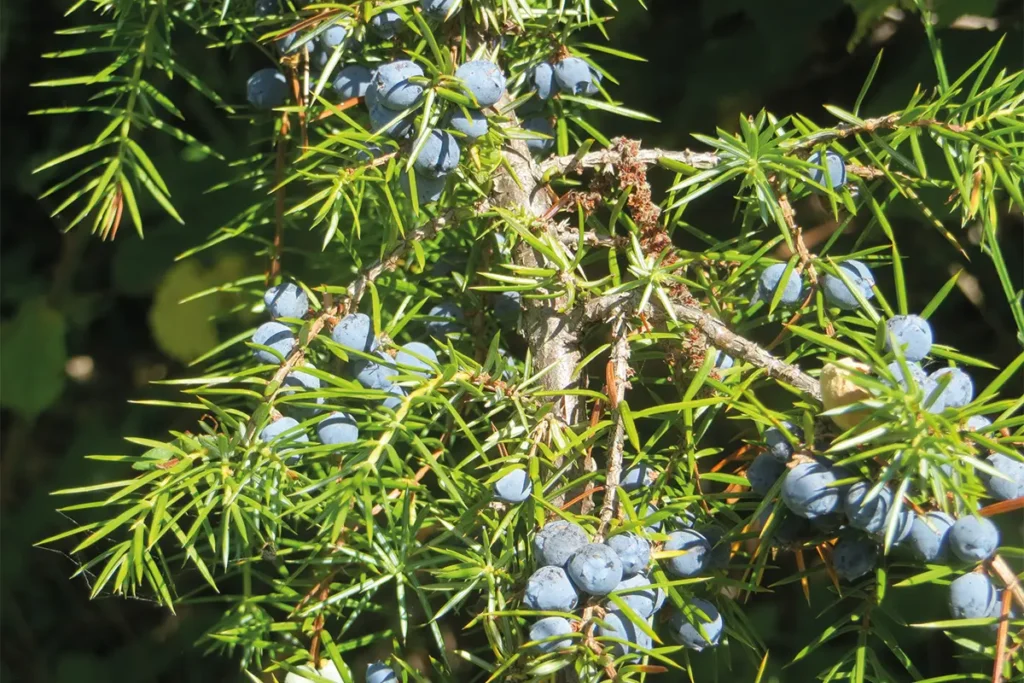


Nome Italiano: Ginepro
Nome scientifico: Juniperus phoenicea L.
Nome Gallurese: Nibbaru femina
Descrizione:
Arbusto sempreverde della famiglia delle Cupressacee, dalle dimensioni modeste fino a 3-6 metri e di lento accrescimento. Ha fusti tortuosi e ramificati di colore rossastro e foglie aghiformi e pungenti. Le piante femminili sviluppano fiori a tre squame che diventano bacche sferiche e carnose, di colore blu-viola, quando mature. Pianta dal profumo intenso, costituisce un elemento fortemente decorativo del paesaggio sardo. Il legno è compatto, duro, resistentissimo, ed ha un colore giallastro all’esterno mentre la parte centrale è rossastra con sottili venature che ne vanno un legname pregiato per lavorazioni artigianali soprattutto per esterni.
Proprietà e usi:
Ricca di proprietà versatili, le bacche vengono utilizzate sia a scopo ornamentale in giardino sia in cucina come spezia. Dalle bacche si ricava un olio essenziale utile per massaggiare parti del corpo doloranti o contratte, dalle molteplici proprietà terapeutiche, dalla peculiare profumazione legnosa.
Curiosità e miti:
Le bacche costituiscono un ottimo alimento per volpi, mustelidi e uccelli. Viene impiegato per il consolidamento delle dune e come frangivento per i retrostanti rimboschimenti per la sua resistenza all’aerosol marino. Dalle bacche di questa pianta si ottengono bevande digestive, in particolare costituisce l’ingrediente essenziale del Gin, dando anche il nome al liquore. La storia di questa bevanda dice che le bacche di ginepro furono scelte per le sue caratteristiche medicamentose, utili nella cura di disturbi quali la gotta e la dispepsia.

Italian name: Ginepro
Scientific name: Juniperus phoenicea L.
Gallurese name: Nibbaru femina
Description:
Evergreen shrub of the Cupressaceae family, modest in size up to 3-6 metres and slow-growing. It has winding, branching reddish stems and prickly, needle-like leaves. The female plants develop three-scaled flowers that become spherical, fleshy, blue-purple berries when ripe. A plant with an intense fragrance, it is a highly decorative element of the Sardinian landscape. The wood is compact, hard, very resistant, and has a yellowish colour on the outside while the central part is reddish with fine veins, making it a prized wood for craftwork, especially for outdoor use.
Properties and uses:
Rich in versatile properties, the berries are used both for ornamental purposes in the garden and in the kitchen as a spice. An essential oil is made from the berries and is useful for massaging sore or contracted parts of the body, with many therapeutic properties and a distinctive woody fragrance.
Curiosities and myths:
The berries make excellent food for foxes, mustelids and birds. It is used to consolidate dunes and as a windbreak for backwoods because of its resistance to marine aerosols. From the berries of this plant, digestive drinks are made, in particular it constitutes the essential ingredient of Gin, also giving its name to the liqueur. The history of this drink says that juniper berries were chosen for their medicinal properties, useful in the treatment of ailments such as gout and dyspepsia.
